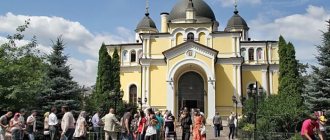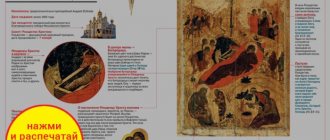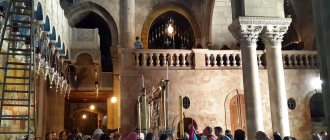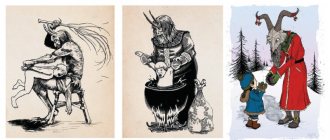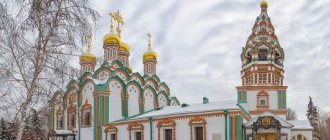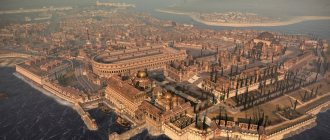An Orthodox church is a place where believers come to pray, confess their sins, listen to the priest’s sermons, light candles, write notes, venerate icons, and order prayer services.
But the temple is not only prayers and notes. After all, this is the place where you can enjoy real art. Yes, yes, art. Not many people know that religion and art are very connected.
Religion and art are closely related to each other.
Over the course of many centuries, art and the Orthodox faith intertwined and flowed into each other, as a result of which Orthodox art arose. Let's talk about what types of arts are found in Orthodoxy.
The Orthodox Church combines 5 types of arts
Namely:
- The architecture of the temple - external and internal decoration.
- Frescoes are wall paintings.
- Fine art - icon painting.
- The art of music is singing prayers.
- Jewelry art includes precious frames on icons, made of various materials, candlesticks, church utensils, church vestments.
Let's talk about each type separately to make it clearer. Architecture and painting are considered bright and fundamental in Orthodox art.
Orthodox churches are priceless monuments of world architectural art. Today in Russia alone there are about 25 thousand different churches and each of them is unique in its own way.
Among them are the world-famous largest Cathedral of Christ the Savior, the unique monastery complex - the Kiev Pechersk Lavra and many others.
Cathedral of Christ the Savior in Moscow. Every day thousands of worshipers come here to worship at the shrines
Beauty is the criterion of truth
However, beauty is not only identical with goodness. Real beauty can and should also be believed. She confirms. Here, for example, is how priest Pavel Florensky formulated it, analyzing Rublev’s famous “Trinity”: “Of all the philosophical proofs of the existence of God, the most convincing is the one that is not even mentioned in textbooks: approximately it can be constructed by inference: there is a “Trinity” Rublev, therefore, is God.” Beauty is identical to truth, is its criterion, its component. [eleven].
St. Vladimir, Boris and Gleb. Double-sided tablet icon. Novgorod. Con. XV - beginning XVI century Tretyakov Gallery
Suffice it to recall the episode of the “test of faith” in The Tale of Bygone Years. Muslims, Catholics, and Khazar Jews have already spoken with Prince Vladimir. A sermon by a Greek “philosopher” sounded before him, containing biblical history and a short catechism in addition, and it seemed to have already made the right impression: the prince states that the Greeks speak “cunningly” and “wonderfully”, that everyone loves to listen to them. And yet preaching is not enough. It is necessary not only to hear, but also to see. And so Vladimir, on the sensible advice of the boyars and elders, chooses ten “kind and sensible men” so that they can look with their own eyes at the visible reality of each faith - in what form does it appear at home?
The envoys carried out the order. The prayer movements of Muslims in the mosque repulsed them because of the alienness of their rhythm and plasticity and seemed joyless: “there is no joy in them.” The Latin rite also did not provide aesthetic satisfaction: “there is no way to see beauty.” But in Constantinople, the patriarch showed them “the beauty of the church,” and they tell their prince: “We don’t know whether we were in heaven or on earth, for there is no such view and such beauty on earth, and we don’t know how to tell about it, We only know that God is with people there and their worship is better than in all other countries. We cannot forget that beauty.” The word “beauty” is repeated again and again, and the experience of beauty serves as a decisive theological argument: “God dwells there with people.” Now the prince can finally make his choice. “Vladimir answered and said: where will we receive baptism?”
Aesthetic argumentation turned out to be the most convincing. Therefore, church music, architecture, and icon painting have always strived to be at the highest level. This was and remains a matter of principle for the Church. A wonderful church choir, the harmony and beauty of worship, the sophistication of architecture - these are the best forms of preaching that the Church has ever known. And this is not the interest of self-interest, an indicator of wealth or empty luxury, but the very essence of the Christian worldview. Precisely because so much depends on the reliability and good quality of beauty, extremely strict requirements are imposed on it. Beauty, which wants to be a proof of truth, cannot help but be harsh towards itself. Beauty and asceticism are very closely related in Russian folk psychology. [12].
Sergey Averintsev
Academician S.S. Averintsev (1937-2004) viewed beauty as holiness. He notes that “classical Russian literature is mortally afraid of aesthetic “pampering.” Gogol burned his manuscript, Leo Tolstoy tried to renounce the artist in himself, just to remain a seeker and teacher of truth - this cannot be found in parallel in the history of other literatures [13]. Let us remember the asceticism of the icon painters - the monks Andrei Rublev, Alipius, glorified as saints. It is impossible to depict the grace resting on a holy saint without having your own experience of the gracious presence of God.
Unfortunately, in today's world, goodness and beauty are at odds with each other. Goodness remains a category of ethics, but beauty turned into abstract aesthetics, and then was completely discredited by modern secular society. Beauty turns into charm, i.e. into a lie. And we have the aesthetics of the market with its temptations, the decline of morality and the loneliness of a person aimed only at entertainment. The loss of value guidelines ultimately leads to oblivion of the very Source of beauty.
St. Isaac the Syrian (VII century) warns that “the soul sees Beauty by the power of its life.” According to N.A. Berdyaev (1874-1948), one must live in beauty in order to recognize it. Having recognized it, each of us partakes of the greatest joy, for the sake of which the Lord created man. The crown of knowledge of the beauty of Divine creation is holiness, which opens in man his own secrets of God-like beauty and reveals the beauty of other people, hidden even from themselves, since “the radiance of the beauty of virtues in man awakens the same wonder and amazement as the glory of Heaven.” [14].
Architecture plays an important role in Orthodoxy
The architecture of the temple is canonical. It has an altar facing east, a main part and a vestibule. In the center of the altar there is a throne.
The throne in the altar on which is the Holy Gospel - which is read by the priest during the liturgy and the Cross
Three doors lead to the altar, one of which is central. It's called the Royal Doors.
This photo shows 2 doors on the sides and 3 doors in the center - the Royal Doors - the priest exits through it during the service
The elevation above the altar is the pulpit, from which the priest addresses the faithful. To the left and right are the choirs, where the singers are located.
There is a bell tower near the temple: the ringing of bells plays a very important role in worship and occurs depending on various occasions, for example, bell ringing, funeral ringing, holiday ringing.
A small bell tower near the temple. Many believers stop specially to listen to this wonderful sound of bells.
The temple also has a dome or domes, of which there may be three, five or more. The number of crosses also depends on the number of domes.
In ancient Russian architecture, the dome took on a peculiar “onion” or “helmet” shape. There is a cross at the top of the dome
LiveInternetLiveInternet
Quote from Natalie_Ladoshka's message
Read in full In your quotation book or community!
Orthodox art.
Orthodox art is eternal and great art, and not only because it has survived two millennia, but primarily because it is a great sacrament, for to this day some icons and images of saints begin to flow myrrh, bleed and heal all infirmities in believers!
Photos in the album “Faith” ladoshka82
on Yandex.Photos
The original original Orthodox icons appeared in the 1st century (and frescoes even earlier) from the Nativity of Christ, when the first disciples of the Messiah, not having strict canons, and being persecuted, painted the image of a shepherd carrying a sheep, a fish and a cross on his shoulders, which were considered the first symbols of Christians.
Much later, they began to paint icons of saints, specific individuals who glorified God through their deeds or martyrdom for Jesus Christ. The very first icon is considered to be a miraculous image, an imprint of blood, sweat and dust from the face of Jesus on the towel with which a good Jewish woman wiped the face of the Savior as he was led to execution. The print was artistically embellished, stylized, and this is how the ancient Orthodox image of the “Savior Not Made by Hands” turned out, one of the first, most ancient Orthodox icons.
After the period of iconoclasm, Orthodox icons began to be painted regularly from about the eighth century to the present day. The First Ecumenical Council of Patriarchs of Christianity of all directions, after long dialogues, canonized holy images and icons of saints, which have since been painted in compliance with strict rules of maximum compliance with the original source. The last icon in the modern universal church is rightfully revered, again not made by hands, the image of the Messiah from the Shroud of Turin. More than five meters of fabric through which the body of the resurrected God passed through, capturing the finest details. This time, it was no longer blood, sweat and dust from a body wrapped in a shroud. It was an unknown isotope that irradiated the tissue so that the appearance of the Son of God was clearly visible in X-rays...
Painting a temple or creating an icon is an extremely complex and very labor-intensive process, requiring almost superhuman effort. The master to whom the order is made, after taking the blessing for his work, must observe a strict fast before starting work and fast throughout the entire writing. While working, he is obliged to read psalms and prayers to those Saints or Saints whose images he undertook to recreate. While working, he does not touch alcohol or women, and often even takes a vow of silence. The restoration of all these works is carried out with no less rigor - a process that requires the greatest responsibility and caution.
Art in Orthodoxy is distinguished by the strictness of the canons that dictate the appearance of the temple building, domes, vestibule, and internal layout of the premises. The order of arrangement of images on the walls inside the temple is also precisely canonized. The iconostasis of each temple is painted with images, which are decorated with icons of saints, angels and archangels, as well as characters from biblical events; The walls and the inside of the dome are also painted in a circle. This is usually the Holy Trinity and the four evangelists, Mark, Matthew, John and Luke, who is one of the first icon painters, painting several images of the Mother of God and some icons of saints, the first martyrs for the faith, one of whom is St. Stephen. Such ancient images have survived to this day, solely thanks to restoration... The art of painting Orthodox icons is also very different from other forms of fine art in its strict adherence to established canons, because Orthodoxy sees in the icon not so much one of the types of art, but a visible expression of faith.
An Orthodox icon is painted on a specially prepared board with a recess and prominent edges. The board is covered with pavolok, onto which soil - gesso - is applied in layers. And already on the gesso, the outline is first drawn, and then the master, who took the order of the icons and the blessing from the priest, paints the image with tempera, paint on egg yolk. The most difficult thing in creating an icon of saints is painting the faces. The paint is applied very liquid so that the shades smoothly flow into each other; last of all, so-called spaces are added to enliven the image by applying light and shadows. The restoration of icons requires the same, even more skillful, approach, which is why not every master will undertake this; you need to be very confident in your strengths and abilities in order to accept an order for icons for restoration. Icons of saints in Orthodoxy should look exactly the same as they came from the brush of the first icon painter...
https://nnm.ru/blogs/Kalter4/vostochno-hristianskoe...o_bolshaya_kollekciya_chast_i/
Series of messages “IZO.
Only masterpieces.": Part 1 - Wonderful paintings! Part 2 - Languid beauties. ... Part 52 - The Great Russian Master - ANDREY RUBLEV. Part 53 - 4 paintings Part 54 - Orthodox art. Part 55 - Pictures of Russian history.
Church singing has always been the favorite art of Rus', and even now
The Orthodox Church is focused specifically on the human voice. Church music is filled with high spiritual beauty.
There is something incomprehensible in it, as many say, that encourages us to think about the most important, most eternal questions - life and death, the meaning of human existence on this earth.
The singers stand on the choir performing various prayers. Previously, melodies and chants were very simple. Now a lot of notes of various chants have been created.
That is why now in churches only specialists who know musical notation stand on the choirs. There are also special books for chants.
In the temple, only specialists who know musical notation stand on the choirs.
The chants are also divided into vocal and non-vocal. Non-vocal musical works were written by church composers. The vocal chants retained some similarity with the ancient modes.
In addition to singing, the service also includes reading. The sacred texts of Scripture and prayers are read. Reading in the temple alternates with singing.
Notes of the troparion for the feast of the Nativity of Christ, tone 4
An example of church singing at Christmas.
Performed by the choir of the Pafnuti Monastery, consisting of only 4 men. Troparion.
The concept of beauty in philosophy
The mystery of beauty has troubled humanity for centuries. In history, many judgments have been made about her. The most ancient civilizations left monuments that capture the aesthetic views of ancient peoples. The Sumerians already in the 25th century. BC. knew writing. The text “Summer and Winter, or Enlil chooses the patron god of farmers” records the first dispute in the history of mankind about the relationship between the beautiful and the useful. The most useful is considered the most beautiful.
Sumerian cuneiform. III millennium BC
The ancient Egyptians expressed some theoretical ideas about the aesthetic properties of the world. Thus, in a papyrus from the Middle Kingdom, the beauty of the Nile is glorified:
Bringer of bread, abundant food, Creator of everything beautiful...
The hymn praising the sun god Aten reads:
You give life to hearts with your Beauty, which is life.
As we see, among ancient peoples, the attitude to the world retained integrity, and aesthetic interest had not yet been isolated into an independent sphere [3]. Thus, “ancient aesthetics begins as one of the facets of philosophizing about nature” [4]. Natural philosophers (VI century BC) believed that beauty is cosmic perfection, the universal harmony of the universe. In Greek, the word cosmos means simultaneously: the universe and decoration, outfit, beauty, order, harmony. Hence the cosmetics.
The Pythagoreans (VI century BC) associated the concept of beauty with the general picture of the world (harmonious cosmos), as well as with the concept of good. Ugly, in their opinion, is evil. The Pythagoreans approached beauty and from a mathematical point of view, calculating harmony, without which beauty is impossible, they spoke about the music of the spheres. According to the Pythagoreans, the universe is a “beautifully sounding orchestra.” The dialectician Heraclitus (c. 520-c. 460 BC) believed that beauty is forever changing and renewed, and harmony is a dynamic balance. The atomist Democritus (c. 460-c. 370 BC) first put forward the category of measure and developed the hedonistic concept: one should live by enjoying, but “one should not strive for every pleasure, but only for that which is associated with the beautiful.” “Proportion is beautiful in everything,” says Democritus, “I do not like either deficiency or excess.”
Lysippos. Bust of Socrates. Roman copy of the 1st century. Louvre.
Socrates (c. 469-399 BC) was one of the first in history to try to understand what the nature and essence of beauty is. He sets out to answer not only the question “what is beautiful?”, but also “what is beautiful?” This, according to the philosopher, is the best, the most perfect of its kind. The beautiful in Socrates is also useful.
Plato (c. 428-347 BC) in the dialogue “Symposium” writes: “The beautiful exists forever, it is not destroyed, does not increase, does not decrease.” The beautiful appears here as an eternal idea, alien to the changing world of things. This understanding follows from Plato’s philosophical concept, which argued that sensory things are only shadows of ideas. Ideas are unchanging spiritual essences that make up true existence. There is also a higher “idea of ideas.”
Aristotle (384-322 BC), unlike Plato, believed that beauty is not an objective idea, but an objective quality of phenomena. It lies in “size and order.” In his “Poetics” he says that the Beautiful is not too big and not too small, it must be proportionate to man. Aristotle emphasized the unity of the beautiful and the good, the aesthetic and the ethical. Images of art should be as beautiful as they are morally high and pure. Art does not always depict beauty, but it always depicts beauty. The world is beautiful - this thesis has passed through the entire history of ancient aesthetics [5].
In the Middle Ages, the concept of the divine origin of beauty dominated. God, spiritualizing inert matter, gives it aesthetic properties. Thus, the beauty of a thing is its spirituality by God. Sensual beauty and the enjoyment of it are sinful. Medieval aesthetics are ascetic.
Renaissance humanists affirmed the beauty of nature itself and the joy of perceiving it. The aesthetics of the Renaissance continues ancient traditions; the beautiful is identified with the moral and just. External beauty is considered an attribute of virtue. Luca Pacioli (1445-1517) puts forward the standard of beauty - the golden (harmonic) ratio. A person, his body, becomes an example of beauty. Leonardo da Vinci (1452-1519) believed that the most beautiful thing is the perfect proportions of objects. The aesthetics of the Renaissance is imbued with humanism and the search for the truth of life. Shakespeare (1564-1616) believed that art is a mirror that the artist holds up to nature; and “the beautiful is a hundred times more beautiful, crowned with precious truth.” Thus, Renaissance aesthetics emphasized the connection between beauty and truth.
Lysippos. Bust of Aristotle. Roman marble copy.
The aesthetics of classicism, the canonical expression of which was given by Nicolas Boileau (1636-1711), identified the beautiful with the elegant. Not all nature is beautiful in its bloom and riot, but only trimmed and well-groomed, such as, for example, the nature of Versailles Park. Boileau substantiated the principles of good taste. He believed that only the truthful is beautiful. Even the ugly is beautifully depicted in art. Imitating the beauty of nature is the main goal of art. The most complete embodiment of the ideals of beauty for Boileau. - a great personality.
The aesthetics of the French enlighteners (XVIII century) is a new stage in the development of the theory of beauty. Voltaire (1694-1778) asserted the relativity of human ideas about beauty: if you ask a toad what is beautiful, it will answer that the embodiment of beauty is another toad. In the aesthetic code “Temple of Taste,” Voltaire says: “False taste is a product of artificiality, while the mother of true taste is nature itself.” French enlighteners believed that beauty is a natural property of nature itself, the same as weight, color, volume.
The romantic F. Schiller (1759-1805) argued that beauty is freedom, the unconstrained development of phenomena according to their inherent laws. The basis of beauty is simplicity, and perfection is natural. Schiller distinguishes the image of the beautiful from the beautiful image. What is ugly in nature can be beautiful in art (beautiful image).
G.V.F. Hegel (1770-1831) finds in beauty only the sensual appearance of an infinite idea. A beautiful object is one in which the idea is most fully manifested. For Hegel, the concept of the beautiful is pushed into the background by the concept of the true: the deeper a person thinks, the closer to the truth, the less he needs the beautiful. In art, according to Hegel, only that which makes it possible to get closer to the absolute idea is valuable.
Orthodox jewelry has a strictly spiritual purpose
Nowadays, jewelers make truly beautiful things. These are crosses, icons in precious frames, church utensils and much more.
Specialized shops selling Christian clothing, jewelry, and various souvenirs also appeared. But many believe that the safest way to buy such things is only in the temple.
Jewelry Mother of God. You can always carry it with you
Gold pectoral cross with handmade diamonds
Orthodox jewelry is always made by hand. They are endowed with the priceless energy of their creator. They bear the imprint of his intention and spiritual content.
All work is done by craftsmen only by hand.
Gold Church Communion Supplies
On the origin of the arts
Back in the 19th century, cultural researchers drew attention to the fact that historically art had its initial forms in cult, religious creativity. According to many scientists, the historical connection between cult (worship) and art is fundamental for understanding the very phenomenon of human culture. The philosopher Friedrich Nietzsche (1844-1900) explored in detail the origin of the art of tragedy and comedy from the ancient Greek mysteries of the cult of Dionysus, i.e. showed the genetic connection of ancient art with religious cult.
Mikhail Bakhtin
One of the pillars of cultural studies, philosopher Mikhail Bakhtin (1895-1975), viewed all culture as the heir of the ancient mysteries, and today partially continuing their functions. This opinion is shared by many Western philosophers and cultural scientists.
S.N. Bulgakov (Marxist, and then religious philosopher; 1871-1944) wrote the following about the origin of culture: “It is known that a religious cult in general is the cradle of culture, or rather, its spiritual homeland. Entire historical eras, especially rich in creativity, are marked by the fact that all the main elements of “culture” were more or less closely connected with cult and had a sacred character: art, philosophy, science, law, economy. From the cradle, art has been entwined with prayer and reverence: at the dawn of cultural history, humanity brings its best inspirations to the altar and dedicates it to God. The connection between culture and cult is generally a fact of great significance in the history of mankind, requiring proper attention and understanding” [15].
The most famous historian of the 20th century, Arnold Toynbee, in his work “Comprehension of History” created the concept of world civilizations that is generally accepted today, according to which each civilization is a whole thanks to a single religious source - a single religion for the entire civilization, a “culture-forming confession” [16]. Arnold Toynbee wrote, for example, about Orthodox (Eastern Christian) civilization, Catholic (Western Christian) civilization, etc.
Temple synthesis of arts
What is the temple synthesis of arts? This is the combination of several different types of art into an artistic whole.
The emergence, as well as the development and existence of the art of different peoples of the world has amazing similarities. Let's look at the example of another temple. For example, Buddhist.
Buddhist temples also incorporated many creative trends:
- architecture;
- sculpture;
- wooden architecture;
- painting;
- embroidery;
- wood carving;
- calligraphy;
- folklore;
- music;
- theatrical performances;
- dancing.
Buddhist temple - created from powerful hewn stones and slabs. The basis for lush and heavy ornamental sculptural decoration, covering almost its entire surface. A peculiar consequence of this is the absence of an arch and vault.
In Buddhist temples, numerous bells hang on the roofs. They sway at the slightest gust of wind.
Exterior view of a Buddhist temple
The buildings themselves are low, they are surrounded by flowers and trees of their own garden.
The territory is protected from the outside world by the same fence or natural barriers, such as trees.
The Golden Hall is decorated with various images expressed in sculpture, embroidery, and painting. These are various faces of Buddhas, deities, saints, good forces, as well as evil spirits and demons.
The first thing we pay attention to is the huge variety of the brightest colors everywhere.
Many people say that being inside a Buddhist monastery, you can feel an indescribable aura of calm and tranquility.
Music comes from the soul of Buddhists and is expressed in songs, for example, in Tibetan throat singing.
Also on the territory of the monastery, magnificent holidays are held, with theatrical performances and ritual dances
What feelings does religious art evoke? Well, we can say that each temple in itself is a masterpiece of world art.
The interior decor with its embroideries, frescoes, altars, bells, aromas, statues leaves no one indifferent, and the musical sound of the word makes you immerse yourself in calm and tranquility.
For example, religious music can inspire a person to reconsider his life views and beliefs, and add a little goodness to his life.
It will be different for each person. Some will like the decor and appearance of an Orthodox temple, while others will be delighted with the interior decoration of a Buddhist temple.
By leaving a comment, you accept the user agreement
Theology of beauty
But beauty is one of the central concepts not only of philosophical and aesthetic thought, but also of theology. The Monk Macarius of Egypt (c. 300-391) writes that a person, wounded by the love of Beauty, is “bound and intoxicated by it, immersed and taken captive to another world.” Nothing awakens the soul more than attention to beauty. In Christianity, Beauty is one of the names of God. God is beautiful in Himself, and He is the source of true beauty [6].
Antonello da Messina. Saint Augustine. 1472 Nat. Palermo gallery.
Here is an amazing hymn to the beauty of St. Augustine (354-430): “I loved You late, true Beauty... You were in me, but I was outside. I sought You externally, disgracing Your proportionate creation with my ugliness. You were with me, but I was without You... You called, and Your cry cut through my deafness; You sparkled, and Your brilliance drove away blindness; Your fragrance has flowed, and now I am suffocating without You... I have tasted You, and now I hunger and thirst; You touched me, and love was kindled in me” [7].
In “Conversations on the Sixth Day” by St. Basil the Great (c. 330-379) speaks as if on behalf of Moses: “The world is a work of art, subject to contemplation by everyone, since through it the wisdom of the Creator is known” [8]. This is a patristic postulate about peace, and Basil the Great remains here a genuine Hellenic, for for the Greeks the world has been a work of art since ancient times [9]. St. Gregory the Theologian (329-389) explains that “beauty is an essential attribute of God,” and St. Cyril of Alexandria (376-444) points out that the beauty of God is supramundane, and man is recreated in this trinitarian beauty, which, according to St. Maximus the Confessor ( 580-662), destined ultimately to be shared with God Himself.
“The Chorus of Patristic Voices” is summed up by Dionysius the Areopagite (1st century): “The saints praise God as the Beautiful, as the Beauty... All that exists, arising from the Beautiful and the Good, being in the Beautiful and the Good, returns to the Beautiful and the Good. And everything that exists and appears exists and appears thanks to the Beautiful and the Good.” Goodness and beauty are identical here [10].
This identity is also confirmed by the ascetic experience of the venerable fathers and ascetics of piety, accumulated over the entire history of Christianity. Already in ancient times, collections of the most authoritative ascetic works of the Holy Fathers in the Church received the name “Philokalia” (love of beauty). The most famous “Philokalia” is a collection of works by Orthodox ascetics, created on Mount Athos in the 18th century. It was translated into Russian with the title “Philokalia”.


